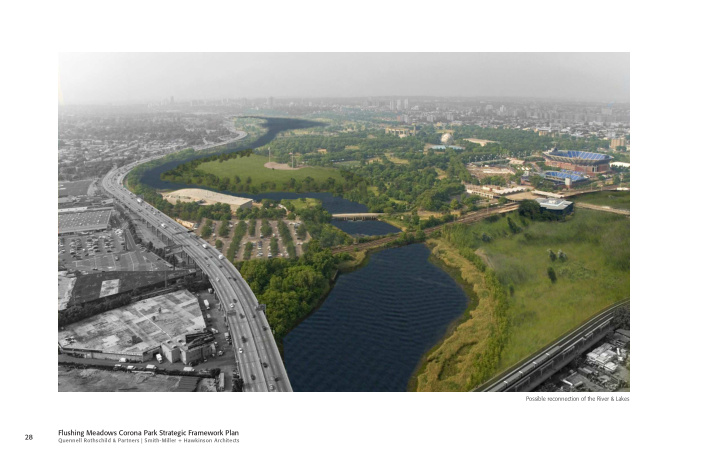



Possible reconnection of the River & Lakes Flushing Meadows Corona Park Strategic Framework Plan 28 Quennell Rothschild & Partners | Smith-Miller + Hawkinson Architects
Vision & Goals Flushing Meadows Corona Park has always been a Park of the Future. Since its resurrection nearly seventy years ago from thirty years’ life as an ash dump, the Park has symbolized the forward-thinking view of a handful of people who recognized the need to improve the environment and to correct past mistakes. vIsIon & Goals We have noted that Flushing Meadows Corona Park has always been a Park of the Future. Since its resurrection would be a good example of this). nearly seventy years ago from thirty years’ life as an ash dump, the Park has symbolized the forward-thinking view • Reduce run-off into adjacent water bodies, especially from paved surfaces and/or fertilized of a handful of people who recognized the need to improve the environment and to correct past mistakes. The landscaped areas. Park’s transformation into the 1939 and, later, the 1964 World’s Fairs provided a frenetic, intensely programmed urban experience, at odds with the goals of a park – especially one which attempts to provide a rural experience in a • All programs should incorporate sustainable goals. heavily built up City. From the period following the World’s Fairs, the Park’s subsequent slide into neglect, has been Through participation of the Park’s institutions (especially The Hall of Science, the Zoo and the recognized by the team as an opportunity to re-envision the Park as a Park of the Future. In today’s terms the Park Botanical Garden) the Park could become a laboratory for environmental science, especially for serves, not only as a memorial to its former glory but, more importantly, as an environmentally healthy, functioning landscape offering both activity and tranquility to its users. the thousands of children who visit it each year. Many of the recommendations in this report could serve as demonstration projects for such a program. While we were developing these ideas Mayor Bloomberg announced the City’s commitment to a sustainable future with PlaNYC. The Mayor proposes a bold plan to use our land in an environmentally responsive way. Other goals for the Park outlined during our initial thinking included: “not only by developing areas ripe for growth, but also by cleaning up brownfields so that no piece of • Establish preeminence. This Park should be treated as one of the most important parks in the New York City is too contaminated to be used for employment, housing, or recreation. The water along City’s system, due to its size and location. At the same time, it is the heart of Queens. our shoreline is cleaner than it has been in generations but we want it cleaner still, so that we can fish, • Consider new or alternative uses for existing Park structures such as the New York State swim, and enjoy the rivers that have always been the City’s most distinctive feature.” Pavilion which are not currently being exploited. We propose strategies for FMPC to play a role in the effort to make a more sustainable world. • Establish the Park as a center for cultural activities. The Park should encourage cultural FCMP should be at the vanguard of this sustainable future. We are proposing that the Park should not merely activities of a variety of scale and type, including performances, traveling exhibitions, temporary be sustainable; but that the Park should become a laboratory for sustainable design where professionals could installations by artists, architects, and scientists, and ethnic and local festivals. These should be undertake serious research and where the public could come to learn about sustainability, and reap the benefits of a chosen in a coordinated way to enhance the experience of the Park. working, healthy system. • Address and articulate the scale of the built landscape. Within this very large Park, there exist To that end we suggest a series of goals for all new and future projects: few opportunities to experience either the grand or the intimate scale of landscape. To alleviate • A net increase in healthy, sustainable, natural areas, with a net gain in vegetation cover to encourage wildlife this problem, develop differentiated scales of open space, topography, and points of view. and improve air quality. Consider the role of the surrounding highways, of structures within the Park (especially those which provide elevated views), and of the perceptual experience of on site circulation. • Reduce rather than increase dependency on private automobile use to access the Park, and encourage walking, bicycling and the use of public transportation. • Require Design Excellence together with innovative landscape and architectural design for all aspects of the Park. • Minimize the amount of material to be disposed of off-site, especially any materials which might be toxic. • Reduce rather than increase energy use both in the construction process and in the fjnal result. (Lighting Flushing Meadows Corona Park Strategic Framework Plan 29 Quennell Rothschild & Partners | Smith-Miller + Hawkinson Architects
Immediate Actions Flushing Meadows Corona Park Strategic Framework Plan Base map: GIS map taken from 2004 FMCP Restoration Framework Plan funded by J.M. Kaplan Fund and NYC DPR 30 Quennell Rothschild & Partners | Smith-Miller + Hawkinson Architects
Recommend
More recommend